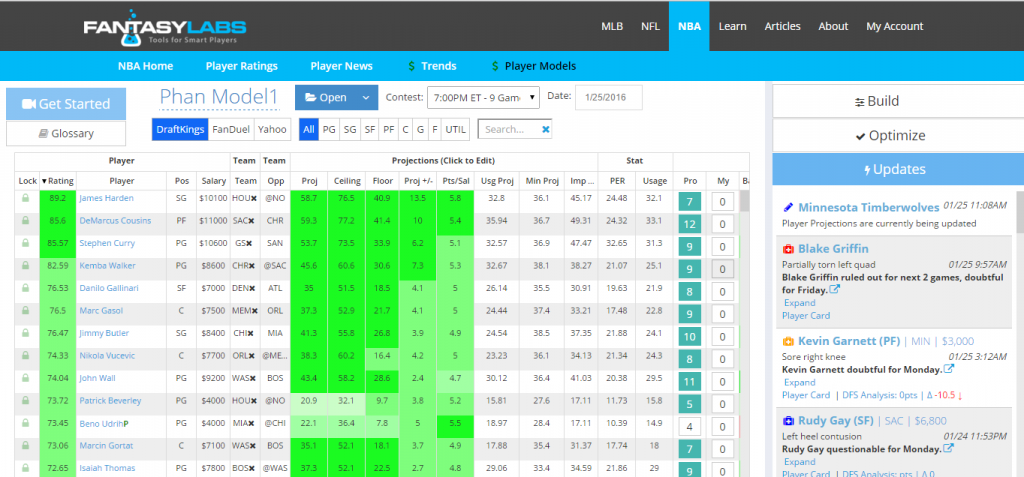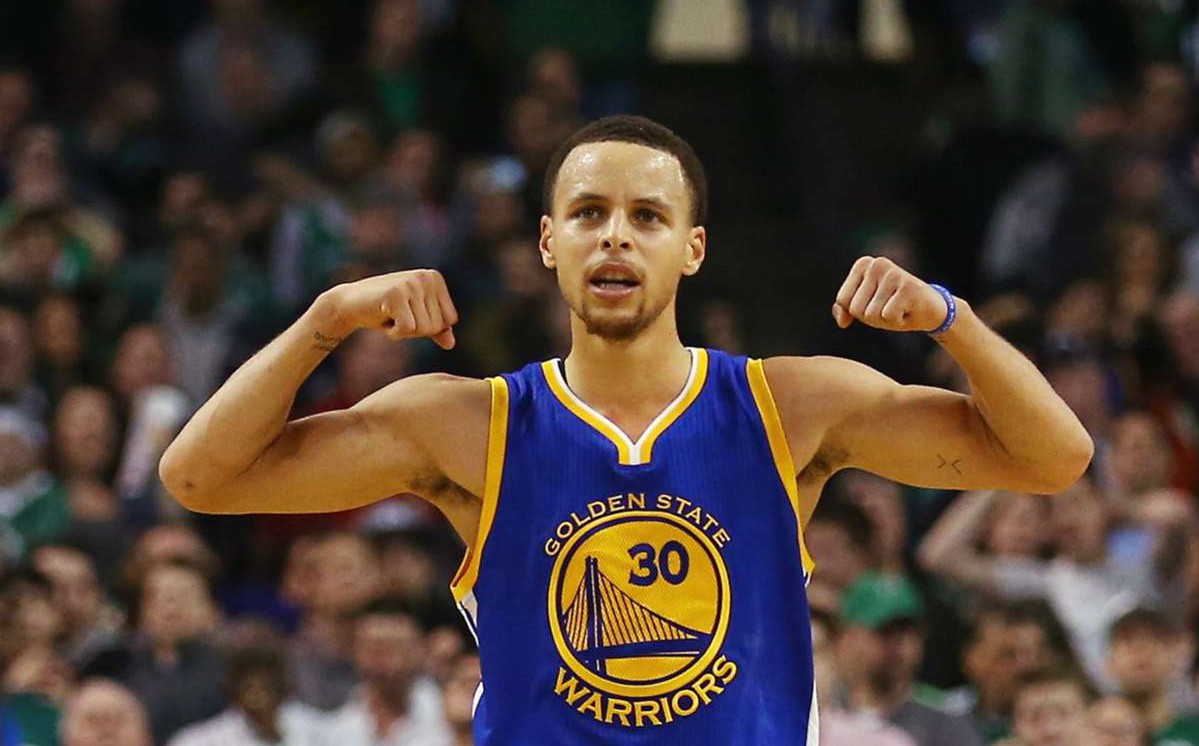Before we get started, let us have a moment of silence for NFL DFS.
The end of the NFL season is a sad day for me. Winter is here and I hate the winter. I’m left asking myself what I should do with my time. I have to wait several months before I can resume sucking at golf four times a week. I don’t participate in any winter sports, unless you consider scraping a one sq. foot of ice off of your windshield and then dangerously navigating through a blizzard in an effort to purchase sour patch kids a sport. Please let me know if that is actually a sport. Nothing would please me more than confirming my long-standing belief delusion that I am an Olympic-caliber athlete.
What I have decided is that I am going to make an attempt at “beating” NBA DFS. I have very little experience with playing NBA, but I do have some experience in making the transition from one sport to another. I think some of the methods I used when making that transition can be useful to anyone looking to get into a new DFS sport.
Last year I decided to make a run at MLB. It was an interesting voyage during which several lessons were learned. I am going to take some of those same lessons and apply them to this transition. Although the sports are very different, I do think that my previous experience will help make fewer mistakes. The goal is to develop a process and become a profitable player in a shorter period of time.
Here are some of the things I will be doing and that I think you should consider if you are going to make this move with me:
Expectations, Goals, and Bankroll Management
“My expectations were reduced to zero when I was 21. Everything since then has been a bonus.”
– Stephen Hawking
Have you ever gotten angry or become disappointed in something or someone who failed to meet your expectations? I have, and I have also noticed that often times it is unjust because I have placed unreasonable or unattainable expectations on that person or thing. I have to remember that when making this transition. I am not going to immediately see the same success that I’ve seen in NFL or the end of the MLB season.
I made a mistake here when I moved into MLB. I played less of my bankroll than I would in an NFL week, but I still played too much. My buddy and I would spend an hour or so on the phone each day discussing the best plays, combing over data, debating game theory, and figuring out how much each of us would be playing that night. I also let some outlier nights of success lead me to believe I was getting better than I was.
My goal is not to profit tonight or this week in NBA. My goal is to become a profitable NBA player. This does not mean that I am not going to attempt to win every time that I play, but rather that I am willing to lose as long as I am learning and getting better in the meantime. This is why I am only going to play a fraction of what I would on a typical MLB or NFL week. I am not willing to simply lose money regardless of how small an amount it is. Although, the small amount of money I am going to play with is an amount that I am willing to invest in learning how to beat this game. That number will be different for everyone, but I can’t stress how strongly I would suggest figuring that number out beforehand.
I am going to set realistic expectations for myself. This is probably obvious and simple. Maybe it is, but I am going to assume that I am not the only one who suffers from delusions of grandeur. The expectation I have is that I am going to continually progress and I will develop a repeatable and profitable process – while using proper bankroll management. The process I develop will be the foundation upon which I become the greatest NBA DFS player in the world.
What was I saying about reasonable expectations? Oh well, let’s move on.
Understanding the Differences
“In constructing concepts, we overlook the fact that no two things are the same…”
– Friedrich Nietzsche
Before I moved into playing MLB DFS, I spent some time researching what some of the differences were. There were so many; correlation and lineup construction was much different, the wind played a larger factor, the ballpark meant much more than it did in NFL, etc. I had to figure out what those differences were before I could even thought about how to exploit them.
This is the same when moving from NFL to NBA. The most obvious differences are that we are able to work with a much larger sample size, the games are daily rather than weekly, and value presents itself in a much quicker and random fashion that it does in NFL.
Seldom will we see and NFL player get scratched within an hour of game time for an illness, a minor injury, or to get some rest. In the NBA, late scratches like this are commonplace. Although it is not recommended, you could manage an NFL Sunday away from your computer. The NBA is a different beast and if we cannot make ourselves available for the hour prior to lineup lock than we put ourselves at a distinct disadvantage.
For that reason, I will not be playing every night. Again, my goal is to develop a process and part of that process needs to be learning how to best react to news.
Herein lies another mistake I made when I began to play MLB: I attempted to play each night regardless of how available I was. I would use the same process on days when the time allowed me to, but would also attempt to play even if I could not rely on that process. I don’t think that much, if anything, is learned by simply playing. Remember, all of my advice is going to center around my idea that the beginning effort into a sport is less about making money now and more about investing in making it long-term.
There are so many more differences that I won’t get into and fortunately a lot of them have already been explained by Bales. I strongly suggest that you take a look at some of the other articles and take in as much information as possible before moving forward. We have to first learn what the differences are before we can figure out how to use them advantageously.
Data, Statistics and Tools
“Statistics are like bikinis. What they reveal is suggestive, but what they conceal is vital.”
– Aaron Levenstein
This is so vital, yet I feel it is no necessary to write about it. That is because I am assuming that if you are reading this that you are also familiar with some of the tools that Fantasy Labs has to offer. Take a look at the Player Models page for Monday night.

Obviously, a screen shot does not do justice to how much information is accessible in that page. Point, minute, and usage projections begin to scratch the surface. I think that these projections are the best and one of the most overlooked aspect of them is how often they are updated.
Here is an example from a few nights ago:

We already talked about how late scratches change the landscape of a slate in just a few chaotic minutes. You can see here that the updates page showed me that Kelly Olynyk was going to get the start and in three minutes the Boston Celtics projections were adjusted to represent that change. I don’t want to speak on strategy as much as I want to talk about tips on making a transition, but I can tell you that this access to sudden changes in projected minutes and usage is something that I plan on heavily using. Having these things happening in real-time is going to allow me to spend more time on building a solid lineup rather than spending the minutes before lock attempting to figure out how these changes affect each player on a team.
Still, we are only scratching the surface of the information that is available to us. I have already dug in and begun to toy around with the trends and models in an effort to see where my time is best focused. This is the next thing I think that anyone getting into NBA should do.
Practice
“For the things we have to learn before we can do them, we learn by doing them.”
– Aristotle
First of all, props to me for resisting the urge to use an Allen Iverson quote on practice. Assuming that we have done our due diligence in learning about some of the differences and that all of us are using the tools available to us, we need to practice.
This is obvious but I wanted to talk a little about how I used the tools and data to practice until I felt comfortable playing at any higher stakes. I came across an MLB league on DraftKings that was a $2 entry winner takes all prize of $120. The maximum entries allowed into this contest were seven. I played in it almost every night until I began to feel comfortable with what I was doing.
When I started to play at higher entry fees I still played in that league for fun. It got to the point where it felt like it was only these two other players or me in contention to win it every night. The time I spent entering that league was invaluable. I tested different theories and strategies, weighing different stats and data until I found a method that I thought was repeatable and profitable. I think it is safe to say that I learned how to play MLB in that contest.
I approach each contest a bit differently, but until I know how to properly build that approach I am going to be useless. I think that anyone starting out should focus on the same contest type until they get a grip on how to play. The stakes at which you decide to practice on is up to you, but I suggest finding a contest size and entry fee that remains fairly consistent in the beginning.
Dig through those contests and study what the field has done. How did they react to the news at 5:30 opposed to the news at 6:50? Why didn’t we see the value in player X who was on the winning lineup? Did we miss something? Understanding our competition won’t be an easy task unless we first begin to compete with them.
Enjoy and Have Fun
“Just play. Have fun. Enjoy the game.”
– Michael Jordan
“Get Rich or Die Tryin”
– Curtis Jackson
I have to be honest here. I find DFS to be a ton of fun, but that is not the only reason I am playing. I want to make some money and I am guessing that everyone reading this has that same idea in mind. Fortunately for us, we already have access to an edge with the tools here. I think that taking a patient approach in learning how to best utilize these tools will lend itself to a profitable future. I don’t play a sport unless I think I can succeed and with the information here I think that success is very possible.
Best of luck to everyone making this transition with me. I began playing this week and will update as I try to beat this game and as I learn my lessons – probably the hard way.





